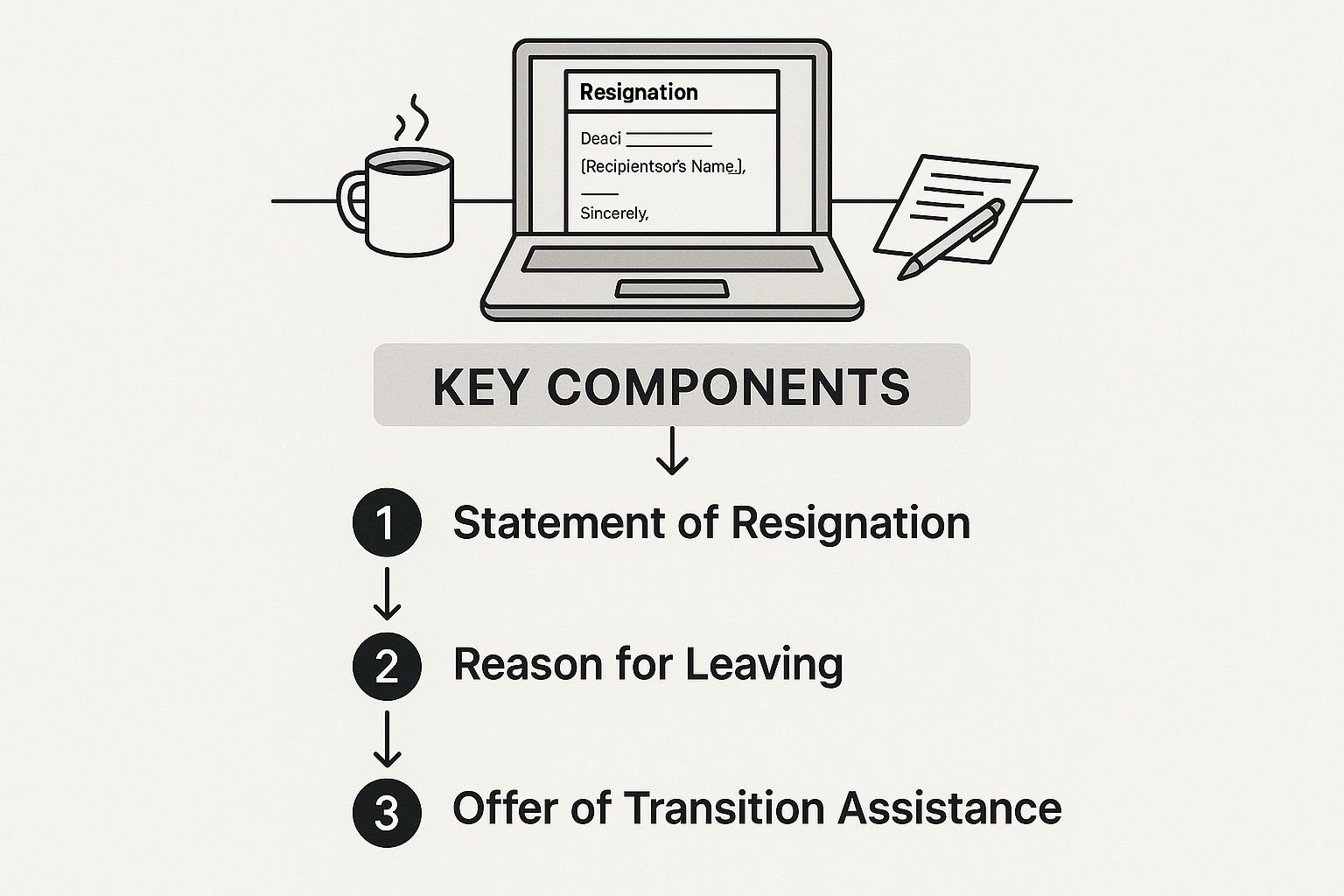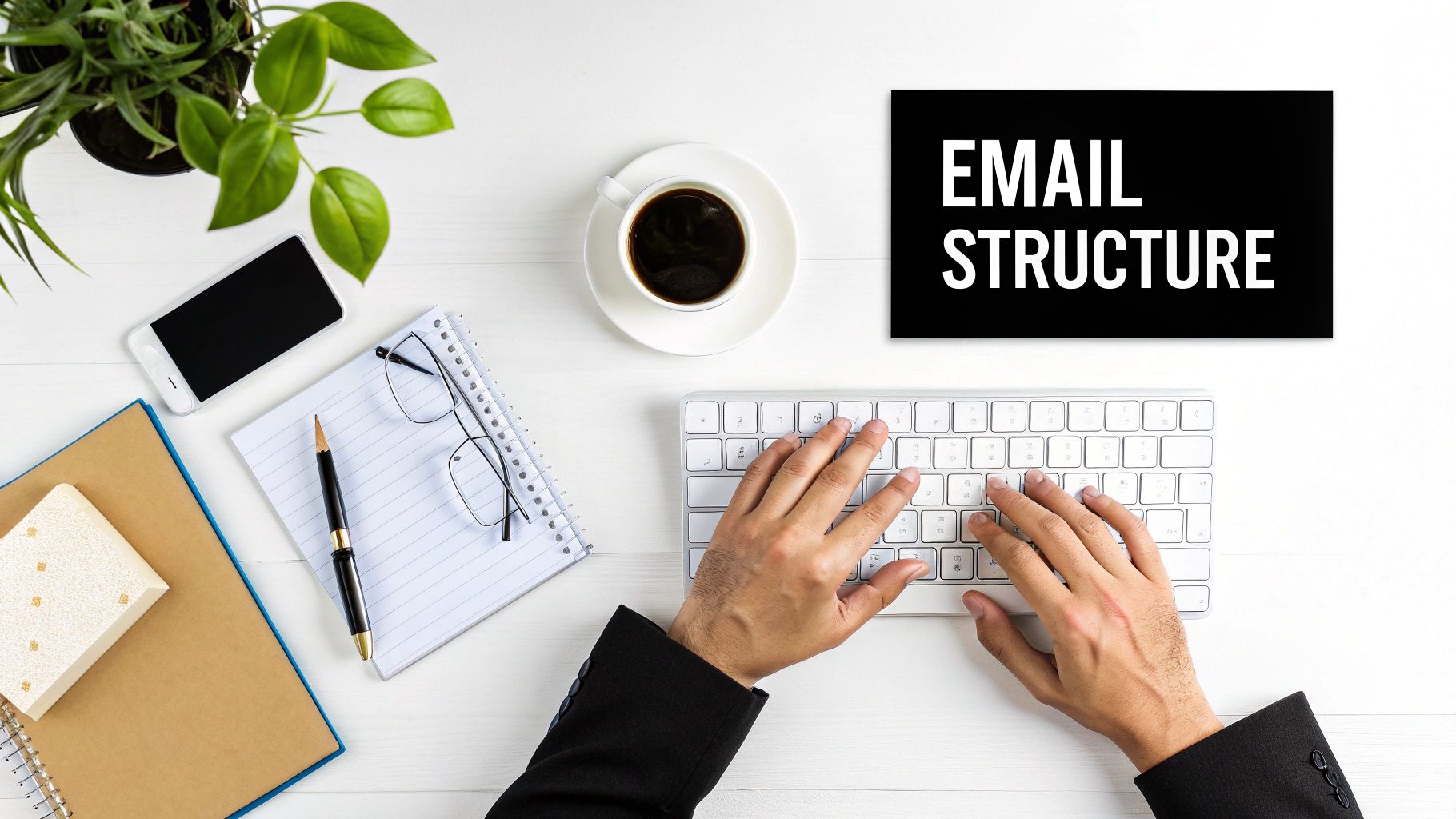When you have decided to move on, knowing how to write your resignation email is key. It boils down to three simple things: clearly state you are leaving, give your last day, and say thank you for the opportunity. This is not just a box-ticking exercise; it is the final impression you will leave behind.
Why Your Resignation Email Is Your Final Impression
Walking away from a job is a significant moment. The decision is personal, but how you announce it is a professional act that will echo long after you have handed in your security pass. Think of your resignation email as more than just a formal notice—it is the final entry in your official record with the company, and it plays a huge part in how your boss and colleagues will remember you.
Getting this right is not just about being polite. It is a smart career move. A thoughtfully written email keeps doors open, preserving professional relationships that could be invaluable for future references, job leads, or even just industry advice down the line. It also sets a cooperative tone for your notice period, which makes the handover a lot less painful for everyone.
Maintaining Your Professional Reputation
In a world where everyone seems to know everyone, especially within the same industry, your reputation is everything. You have heard it a million times, but it is true: do not burn your bridges. You genuinely never know when you will cross paths with old colleagues or managers again. A respectful resignation email cements your image as a professional who handles things with class.
Your resignation is the last chapter you write at a company. Make sure it is a good one. It reflects your professional integrity and can influence future opportunities in ways you might not expect.
The Australian job market is a perfect example of why this is so important right now. We all remember the 'Great Resignation' when employee turnover spiked at 21.4% back in 2022. But things have settled, dropping to 10.8% in early 2024 as people prioritise job stability.
With fewer people jumping ship, the way you leave a role is under more scrutiny than ever. Nurturing those professional relationships as you exit is critical. If you want to dig deeper, you can explore more data on this employment trend and see what it means for workers here. Taking a careful, considered approach turns a simple departure into a chance to strengthen your network for whatever comes next.
The Anatomy of a Flawless Resignation Email
Writing a good resignation email is not about following a strict, formal template. It is more about putting together the right pieces in a way that is clear, respectful, and leaves no room for confusion. You are aiming for a message that is direct but still courteous, making sure everyone knows exactly what is happening.
From the moment your manager sees the subject line to the final sign-off, every part of the email helps shape their final impression of you.
This visual guide shows you exactly how these components come together in a real-world example.

As you can see, a great email has a logical flow that keeps things professional and easy to understand.
The Five Must-Have Components
So, what are the essential ingredients? Every solid resignation email needs five key parts. Each one builds on the last to create a message that gets the job done without burning any bridges. Getting these right is crucial.
A Crystal-Clear Subject Line: This is your first impression and arguably the most important part. Do not get creative here. Something simple like "Resignation – [Your Name]" is perfect. It is impossible to miss in a crowded inbox and tells your manager exactly what to expect.
A Direct Statement of Resignation: Get right to the point in the very first sentence. There is no need for a long preamble. "Please accept this email as formal notification of my resignation from my position as [Job Title]" is professional, direct, and unambiguous.
Your Last Day of Employment: Be specific. Clearly state the date you intend to finish, making sure it aligns with your notice period. For instance, "My last day with the company will be [Date]." This gives your manager and HR the information they need to kick off the offboarding and handover process.
Your email serves as an official document. Its main job is to clearly state the facts: you are leaving, what your role is, and when your last day is. Keeping this core message simple prevents any potential confusion down the line.
A Quick Thank You: You do not need to write a novel, but a short, genuine note of gratitude goes a long way. It shows you value the time you spent there. Something like, "I'm grateful for the opportunity I have had here, particularly my work on the [Project Name] project," adds a nice personal touch.
An Offer to Help with the Handover: Ending on a helpful note reinforces your professionalism. A simple sentence like, "I am happy to do whatever I can to ensure a smooth transition over the next two weeks," shows you are committed to leaving things in good order. It is a small gesture that leaves a lasting positive impression.
To make it even clearer, here is a quick breakdown of what each part does and what it can look like.
Key Components of Your Resignation Email
| Component | Purpose | Example Phrasing |
|---|---|---|
| Clear Subject Line | To ensure the email is opened and its purpose is immediately understood. | Resignation – Jane Smith |
| Direct Statement | To formally announce your intention to leave, leaving no room for ambiguity. | Please accept this as notice of my resignation from my role as... |
| Your Final Date | To provide a clear timeline for your departure and kickstart the handover process. | My last day of employment will be Friday, 28th June. |
| Note of Gratitude | To maintain a positive relationship and acknowledge the opportunities you received. | Thank you for the opportunity to have been a part of the team. |
| Offer of Assistance | To demonstrate professionalism and your commitment to a smooth transition. | I am committed to helping train my replacement and document my responsibilities. |
Putting these elements together ensures your resignation is handled professionally, helping you maintain your network and reputation long after you have moved on.
Crafting a Positive Tone to Leave on Good Terms
The words you choose are important, but it is the tone of your resignation email that really sticks. Getting this right is how you leave a lasting, positive impression. It is about maintaining a cooperative and grateful voice to ensure you part on the best possible terms, keeping professional relationships intact for the future.
This is not about being disingenuous. It is about professional courtesy.
Even if things were not always perfect, your resignation email is absolutely not the forum to list your complaints. Instead, focus on the positive aspects, no matter how small. Perhaps you are grateful for the opportunity itself, a new skill you picked up, or the support you got from a specific manager or teammate. A little genuine gratitude goes a long way and is something people remember.
Frame Your Departure Constructively
How you position your exit says a lot about you. Rather than dwelling on any frustrations that might be pushing you out the door, frame it as a positive step forward in your career. This makes you look professional and ambitious.
Think about it in one of these ways:
- Highlight the new opportunity: Briefly mention you are moving on to a role that presents a new challenge or is a better fit for your long-term goals. You do not need to go into great detail.
- Keep it simple and neutral: Remember, you do not actually have to give a reason. Sometimes, a straightforward, professional notice is the cleanest way to handle a tricky departure.
Your goal is to be remembered as a professional who managed their exit with grace and integrity. A positive tone ensures your final communication is a testament to your character, not a summary of your complaints.
Nailing this approach is key to a smooth exit. For a deeper dive into the whole process, you can find more detailed advice on how to resign professionally to make sure you handle every step correctly.
Ultimately, you want your email to cement your reputation as a considerate and professional person. By keeping the tone upbeat and helpful, your final message becomes one of respect and appreciation—leaving the door open for whatever comes next.
Getting the Timing and Delivery Right

Knowing what to write in your resignation email is half the battle. The other half? Nailing the when and the how. The way you handle the logistics of your departure can genuinely shape your final weeks and determine whether you leave on a high note or under a cloud of awkwardness.
First things first: always try to have a quick, face-to-face chat with your direct manager before you hit send. No one likes being blindsided by an email, especially with news like this. It is a simple sign of respect that speaks volumes about your professionalism and makes the whole process smoother.
Sending Your Resignation Email
Once you have had that initial conversation, it is time to send the formal email to make it official. Who you send it to matters.
- To: Your direct manager. They should always be the primary recipient.
- CC: A representative from Human Resources (HR). This ensures the official process kicks off without delay.
Now, let’s talk timing. Sending your resignation late on a Friday afternoon is a classic rookie mistake. It can come across as you trying to avoid the immediate follow-up conversation. A Monday or Tuesday morning is usually the best bet. This gives your manager and HR the entire week to start figuring out a transition plan.
Your resignation is not just about you leaving; it is an official business process. By handling the news thoughtfully and using the right channels, you show respect for your colleagues and the company’s procedures.
This kind of professional courtesy is more important than ever. The Australian Bureau of Statistics reported that a staggering 534,700 Australians chose to leave their jobs in the 12 months to February 2025. With so many people moving roles, good etiquette is what helps you maintain a strong professional reputation. You can dig deeper into this and read the full job mobility data on the ABS website.
Learning to manage these tough conversations is a valuable career skill. If you are looking for more advice on this, we have got a great guide on how to deliver difficult news in the workplace.
Resignation Email Examples for Different Scenarios

It is one thing to talk theory, but seeing how it all comes together in practice is what really makes it click. Let us look at some real-world examples. While your situation is unique to you, a good, solid template can give you a fantastic starting point to work from.
This core structure hits all the crucial notes we have talked about: being clear, showing gratitude, and promising a smooth handover. It is professional, gets right to the point, and you can tweak it for almost any scenario.
A Go-To Resignation Template
Here is a straightforward template that you cannot go wrong with in most professional settings. Notice how it is direct but still maintains a warm, courteous tone.
Subject: Resignation – [Your Name]
Dear [Manager's Name],
Please accept this email as formal notification that I am resigning from my position as [Your Job Title] at [Company Name]. My last day of employment will be [Your Last Day].
Thank you so much for the opportunity to have been part of the team for the past [Number] years. I have genuinely enjoyed my time here and I am grateful for the support you have given me.
I am committed to ensuring a smooth transition during my final two weeks. Please let me know how I can best help with handing over my duties.
| I wish you and the company all the very best for the future.
Best regards,
[Your Name]
This is a brilliant foundation. Now, let us see how you can adapt it for a few common situations you might find yourself in.
Example 1: Leaving for a New Career Opportunity
When you are heading off to a new role, the key is to express genuine thanks and leave on a high note. There is absolutely no need to name your new company; just keep it positive.
Subject: Resignation – Alex Chen
Dear Sarah,
Please accept this as notice of my resignation from my role as Senior Developer. My final day will be Friday, 28th June.
I have accepted a new position that I feel is the right next step for my career goals. I am incredibly grateful for the experience and mentorship I have received at [Company Name] over the last three years.
I am dedicated to making this a smooth handover. I will make sure all my project documentation is up-to-date and am happy to help train my replacement.
Thank you again for everything.
Best regards,
Alex Chen
Example 2: Resigning for Personal Reasons or Study
If you are leaving to go back to university or for other personal reasons, you can be brief and professional without oversharing. It is about keeping the focus on your professional departure, not the nitty-gritty of your personal life.
Subject: Notice of Resignation – Maria Garcia
Dear Tom,
I am writing to inform you that I will be resigning from my position as Marketing Coordinator, effective two weeks from today. My last day will be Friday, 28th June.
I have decided to return to university full-time to complete my Master’s degree. This was not an easy decision, and I want to thank you for the wonderful opportunity to work with the team.
I will do everything I can to wrap up my responsibilities and assist in the transition process over the next couple of weeks.
Sincerely,
Maria Garcia
Common Resignation Mistakes and How to Avoid Them
Even with the perfect template in hand, it is surprisingly easy to fumble your resignation. Leaving a job requires a clear head, because one wrong move can make for a tense notice period and even tarnish your professional reputation for years to come.
The biggest mistake? Letting your emotions do the talking. Your resignation email is absolutely not the place to air every grievance or get overly sentimental. Treat it as a formal piece of business communication—your main goal is to keep the tone professional and neutral from start to finish.
Keeping Your Departure Professional
Another classic misstep is oversharing details about your fantastic new job. Of course, you are excited, but going on about your new salary or amazing role can easily come across as bragging. It is much classier to frame your departure as a positive career move for yourself, without drawing direct comparisons that can create awkwardness.
Interestingly, research from the Australian HR Institute reveals that 'excessive workload' (26%) and 'poor workplace relationships' (21%) are among the top reasons people actually leave. A smart resignation email, however, steers well clear of these negatives. You can discover the full insights from AHRI's report to see what drives employee turnover.
Instead, keep your focus on two things: expressing genuine gratitude for the opportunity and promising a smooth, cooperative handover. This is how you protect your professional legacy.
Remember, the whole point of a resignation letter is to secure a clean, positive exit. Venting your frustrations in writing will only burn bridges you might need to cross again later in your career.
One final pitfall to watch out for is getting roped into a counter-offer conversation before you are ready. It is a good idea to think through how you would handle that before you even hit send on your email. For a deeper dive, check out our guide on the truth about counter-offers and what you need to know.
By sidestepping these common mistakes, you can make sure your final impression is one of total professionalism and grace.
At Redwolf Rosch, we have deep expertise in matching IT and Digital professionals with organisations undergoing transformation. If you are looking for a trusted, high-performing recruitment partner, get in touch for an introductory discussion today.
 Submit CV
Submit CV Submit vacancy
Submit vacancy  Call for a Candidate
Call for a Candidate